Kinsley White, 6; Ralph Yarl, 16; Payton Washington, 18; Kaylin Gillis, 20; Heather Roth, 21.
Over the last week, these children were shot over bouncing a ball, ringing a doorbell, pulling into a driveway, and mistakenly opening the wrong car door. One of them, Kaylin, was killed.
Is this pro-life, America? Protecting fetuses but not the humans they become?
What was that word? Yes “deplorable”. A quote from the Boston Globe this week nails the sickness.
No Flack at Yack
I am writing this blog in the Yackandandah motel. Yackandandah is one of those places where the name seems so ridiculous to be so very identifiably Australian – you know like Tangambalanga or Bullamakanka or Woomargama.
It is a beautiful time to be in Northern Victoria with the trees showing off their autumnal finery. Yackandandah is a small village along the way Hume and Hovell passed as the first whitefellas to penetrate the country south to Corio Bay, starting from Hume’s property at Appin in NSW south of Sydney. The year was 1824, when Hamilton Hume who had been born in the Colony was 27 years old. He was joined by William Hovell, ten years his senior, for this great adventure. Along the route, their achievements are recognised by a series of obelisk monuments, one of which lies in a grove of oak trees on the Wodonga – Yackandandah Road. As I have driven this road many times, my wife suggested we stop and see why at this place called Staghorn Flat there is this magnificent grove of English and pin oak trees bordered by golden poplars – an exotic setting along a bush road where otherwise eucalypts and wattle dominate.
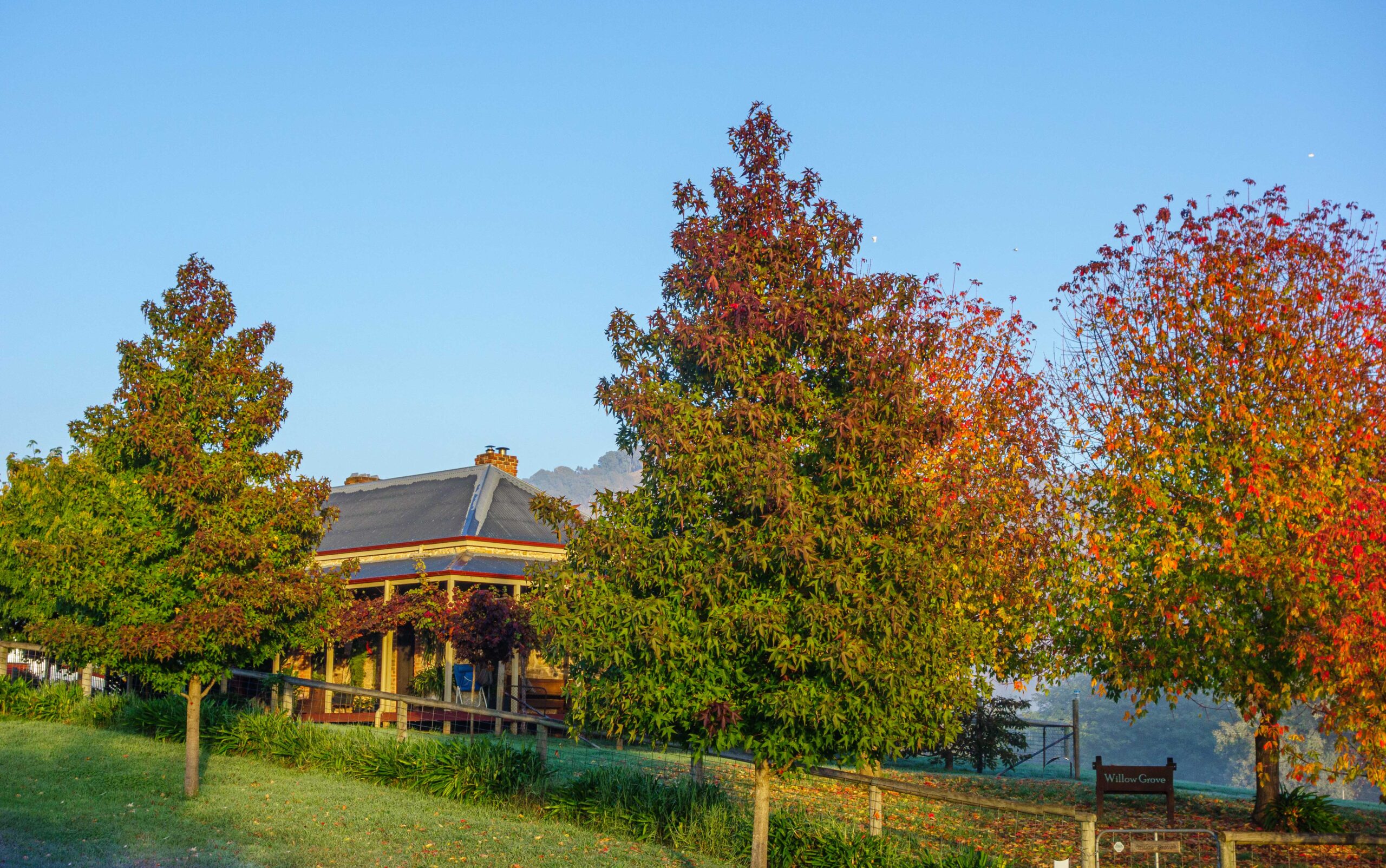
Just along the road is the stone cottage where Aunt Minnie and Uncle Alf once lived; she points it out. Once derelict, the house was where these Lutheran pioneers once earned a living from dairy farming. There is thus a family connection to Staghorn Flat. After all, people had first come to Yackandandah and Staghorn Flat and Freedom Creek in search of gold in 1852. The original landowner had dismissed the idea that there was any gold. To him, gold was only found in Russia. No, mate that is not mica, that is the genuine stuff. Originally alluvial, deep mines were sunk and gold mining became a serious activity for the next 50 years.
The grove was the brainchild of those locals who wished to have a memorial for those who had served in the War and also to venerate the headmaster of the Staghorn Flat school. He had returned from the First World War, and it was decided that such a memorial should be planted along the road near the school to remember those who had not returned. Planting trees was a favourite method of honouring the dead, but these have, particularly on the eastern side of the road remained sturdy; and what a way to be remembered, when you lie somewhere in the fields of France. The Staghorn school closed and was demolished in 1990.
This road through the grove unfortunately is a raceway, and the cars and trucks zoom past, never stopping for the drivers and passengers to wander among the yellowing foliage and the crackling carpet, a legacy of brown leaves and acorns. I’m glad we stopped.
Kilted Up
In a submission to the Australian Law Reform Commission, the Presbyterian Church of Australia said it was essential that its schools “have the freedom to employ staff who are not merely in agreement with our ethos but who also live in a manner consistent with that ethos”.
The church said its schools “do not refuse or terminate enrolments for students on the basis of sexual orientation” and were not seeking to do so. But it argued that schools should have the right to stop sexually active heterosexual or LGBTQ+ students becoming school captains.
“If this [LGBTQ+] student was in an active same-sex relationship, they would not be able to give appropriate Christian leadership in a Christian school which requires modelling Christian living,” it said. – edited report from The Age
The diminishing band of Scottish Calvinists, Presbyterians who remained separate when the Uniting Church was formed, secured some of the juiciest real estate, part of the booty being Scotch College in Melbourne. The Church issued an edict to the effect that it wants its staff and students in the single sex school to be red-blazered heterosexuals. In response, the Captain of Melbourne Grammar School, incidentally another single sex school, wrote an opinion piece for The Age, stating he was gay and making an impassioned plea for tolerance and implying that his school now encouraged such attitudes. Well he was, after all, the Captain of School.
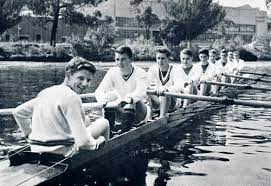
I am an old Melburnian myself, and in those days there was always that cry, mostly from Scotch boys at the Head of River in particular, of “if you can’t get a girl, get a Grammar boy”. Tolerance in those days took a different form.
I had a friend at school who had been a scholarship boy from one of the unfashionable suburbs, very like the suburb in which I grew up in the south-east of Melbourne. He was a gentle fellow, kind and considerate; he used to date the daughter of the school chaplain and was responsible for introducing me to one of my girlfriends. After we left school, he and I with a large cohort of fellows from our Year 12, started medicine at the University of Melbourne. However, in second year, he could not cope with the dissecting room. He dropped out of medicine at the end of that year and left for the United Kingdom, eventually drifted into a religious calling. He became an Anglican monk, and later I heard he had died of AIDS. I saw him very rarely after he left medicine once he relocated to the United Kingdom; he did not come back to Australia very often. When I did see him, he had “come out” without explicitly stating that he had. That was the word “explicit”, and since Melbourne Grammar School was a boarding school, I am sure there would have been covert homosexuality, but it was not a topic in the quadrangle.
Daniel Cash, the Melbourne Grammar School Captain, has had his “line in the sand” moment. It is a pity that he had to say what he did because for that he will be long remembered; and there are those in this malevolent world he will enter who will not remember kindly.
To the credit of the Scotch College Council, it has pushed back against the Church edict.
But it started me thinking. Would Cash have been afforded the same status and hence platform if he were a student at an Anglican School in the Sydney Diocese?
Douglas Brass, the father of Alister John Douglas Brass
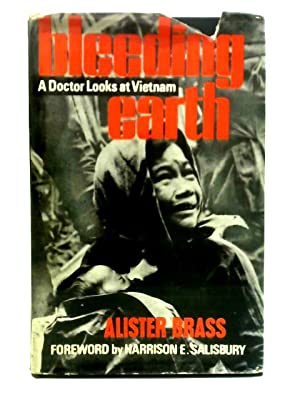 Alister Brass, in a written inscription on his book Bleeding Earth: a doctor looks at Vietnam written when he was a war correspondent in Vietnam, which he gave to me, dedicated it to “Me mate” – an ironic appellation but then we were the epitome of “The Odd Couple”.
Alister Brass, in a written inscription on his book Bleeding Earth: a doctor looks at Vietnam written when he was a war correspondent in Vietnam, which he gave to me, dedicated it to “Me mate” – an ironic appellation but then we were the epitome of “The Odd Couple”.
I have penned a substantial amount about my friend, Alister, who died of AIDS in 1986, and even now nearly 40 years on I miss him dearly.
The poem below is very much my lament. I am publishing a few of my poems and the poem about Alister, written soon after his death, is among them. In explanation, at the time of his death I was in Louisbourg, a town located on the austere Cape Breton Island that juts out from the Canadian Atlantic Coast.
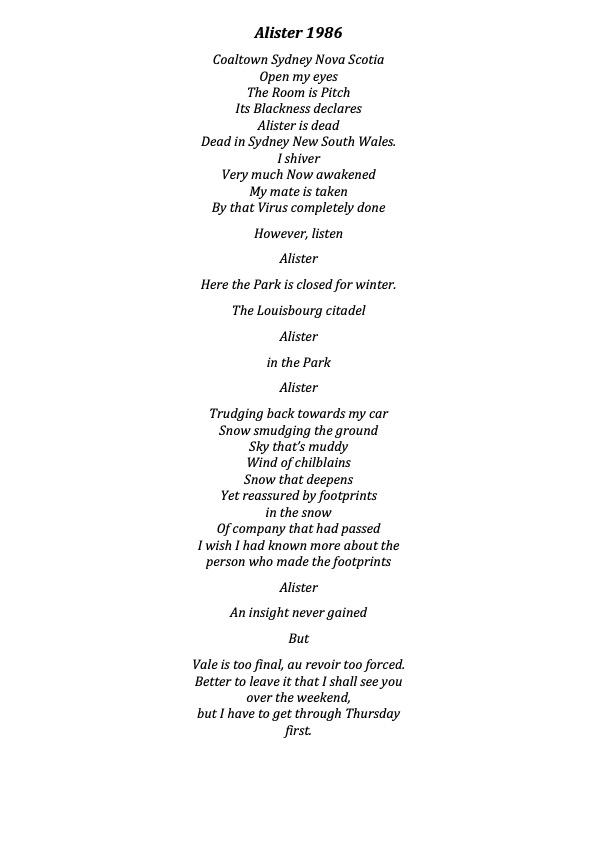 I must say it has been a long Thursday!
I must say it has been a long Thursday!
His father, Douglas Brass, wrote the following letter to me after his death.
Thank you for your note about Alister and the somewhat mystical dream essay. We take it you had found someone in Alister, who trod the same sort of path through this dark world of ours
Anyway do send me a copy of your journal. We don’t see the MJA {Medical Journal of Australasia of which Alister had been Editor 1983-85} now but we trust you are still entertaining its readership with your column and other pieces.
You were a comfort to Alister in the jungle. I imagine you had lots of things in common apart from good food and talk.
Again, thank you for getting in touch.
It was a warm letter, but I never met him. He did not invite me to come and meet him. But then why should he? The letter was enough.
Alister did not talk about his father much, although I knew the family was close to the Murdochs. I remember meeting Larry Lamb at Alister’s house in Paddington, at the time Lamb was briefly editor of The Australian and Alister was sounding me out to be a columnist on The Australian. Lamb was an extrovert Yorkshireman who had been editor of Murdoch’s Sun in the UK when it introduced “the page 3 girls”. He did not last long in Australia, where he was given the sobriquet “Sir Loin” by the local staff.
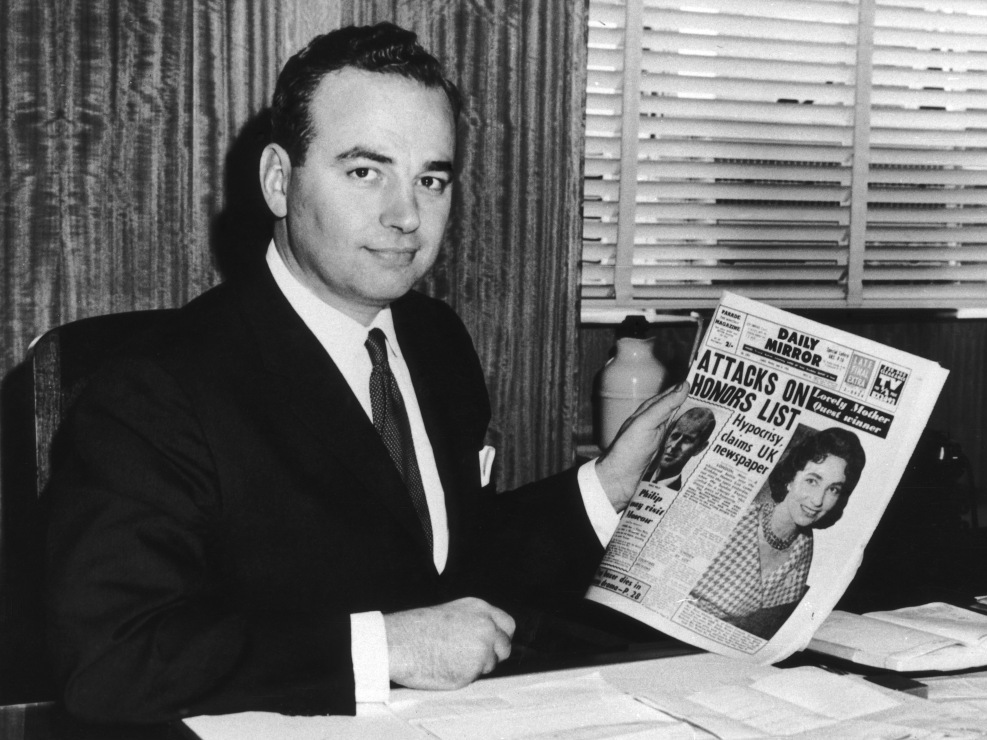 Rupert Murdoch takes over the Daily Mirror in 1960
Rupert Murdoch takes over the Daily Mirror in 1960
A New Zealander originally, Douglas Brass was a far different personality from Murdoch’s later directors. Douglas first formed a friendship with Keith Murdoch after going to work for him in 1936 at the Herald & Weekly Times. Then later on, after a stint as war correspondent, he was a major mentor for his son Rupert in his early newspaper days, after Keith Murdoch had died in 1952. Douglas was known for his liberal and temperate approach, helping steer The Australian through its early days in the 1960s, when he was Editorial Director of News Limited until 1970, at a time when he opposed Rupert’s acquisition of the British tabloids.
The Australian Dictionary of Biography says it better about Douglas Brass than me paraphrasing the following:
He made a series of important appointments to the Australian, including Adrian Deamer as editor and Mungo McCallum as a political journalist, as well as selecting its London and Washington correspondents. Opposing the escalating Vietnam War on moral grounds, he contributed powerful feature articles to the Australian in 1969 attacking both the war and conscription. A critic of Menzies, he believed Harold Holt to be merely a ‘yes man’ on foreign affairs, but he held out hope for a future Whitlam-led Labor administration.
It should be remembered in this context that Murdoch supported Whitlam in the 1972 election. Douglas Brass retired to Mt Eliza, maintained close contact with Elisabeth Murdoch, whose Cruden Farm was not that far away, and wrote occasional pieces until his death in 1994.
The Daguerreotype of Deception
The novelist John Banville, writing in the New York Review of Books, makes an astute comment: As we know, the camera does lie, frequently and flagrantly – consider the fashion industry – but sometimes, with some people, the lens insinuates itself behind the mask to starkly revelatory effect.
I thought his comments very apt when I saw an advertisement for Louis Vuitton which appeared on the back cover of a recent issue of The Economist, although it was pointed out to me that it was not the camera that lied, but rather the manipulation of the picture subsequently.
The subject of the photograph is vaguely familiar, a metrosexual representation of the relaxed successful young executive surrounded by an array of Louis Vuitton Luggage. What attracted me was the pair of expensive black elastic-sided boots, of which he had been shod but never worn. They seemed to be R.M Williams footwear, and I remembered that LV had owned R.M. Williams for a time.
 But back to elegant lounger. Suddenly, it struck us. It was Lionel Messi, but this was not the scruffy homunculus darting around the football field, ablaze with tattoos. The face looking out of the photograph was imperious with a touch of the Hugh Jackman with the clipped beard. The hair cut was modish, and the legs seem to be much longer than those which we are accustomed to see striking the ball, certainly longer than a mere camera angle could have achieved. The tattoos are covered by an elegant long-sleeved knitwear.
But back to elegant lounger. Suddenly, it struck us. It was Lionel Messi, but this was not the scruffy homunculus darting around the football field, ablaze with tattoos. The face looking out of the photograph was imperious with a touch of the Hugh Jackman with the clipped beard. The hair cut was modish, and the legs seem to be much longer than those which we are accustomed to see striking the ball, certainly longer than a mere camera angle could have achieved. The tattoos are covered by an elegant long-sleeved knitwear.
A John Banville moment.
The Samaritan Today
Yeshiva University is a private Orthodox Jewish university with four campuses in New York City. Steven Fine, professor of Jewish history at Yeshiva University and director of the university’s Israelite Samaritans Project wrote recently in the Washington Post (sic):
When my oldest son was in fourth grade, he was studying in a Talmud class preparing for the Jewish New Year. The teacher arrived at a passage that describes the nefarious Kutim, an ancient expletive for Samaritans. The rabbi explained how these awful Kutim disrupted communication of the date of the new year from Jerusalem to surrounding communities some 2,000 years ago. No “good Samaritans” here.
He told the boys that the Kutim were descendants of false converts who persist in attacking “us.” Looking up, the teacher saw that my boy was upset. “What’s wrong?” he asked. “Rabbi,” my son replied, “my dad has a friend who is a Samaritan. Calling Samaritans ‘Kutim’ is like using the n-word.” The kindly teacher had no answer. Soon after, he sought me out for more information.
So this Passover, meet the modern-day Samaritans. Though we speak of good Samaritan laws that protect do-gooders and good Samaritan hospitals that heal us, in fact, this small religious group has barely survived centuries of hate and mistrust in a region riven by conflict.
The fact that they were widely despised in antiquity is a key element of the New Testament parable for which their name is known. In the gospel story, a Jewish traveller had been robbed, beaten and left for dead. A passing Jewish priest walked past the suffering man without stopping, as did a Levite. A man of the hated Samaritan people finally rendered aid. The story is not just about helping a stranger but also helping and being helped by someone who looks like an enemy.
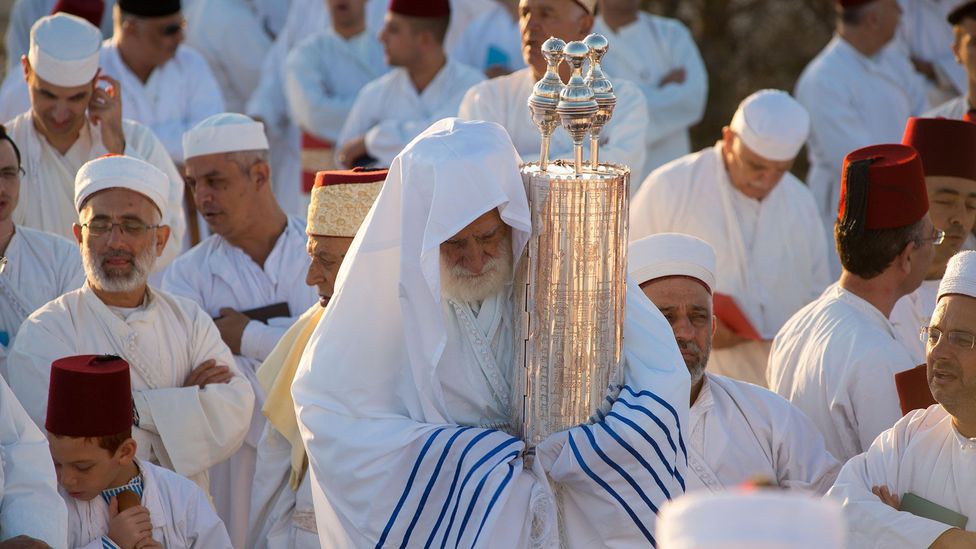
Samaritans, like Jews, are descendants of ancient Israelites. They trace their lineage to one of the “lost” 10 tribes of the northern Kingdom of Israel. They call themselves the Shemarim, the “guardians” of the Torah, and revere the Pentateuch, the five books of Moses.
Samaritans are not Jews or Arabs. They are both, and neither — all at the same time. Half live in the Israeli city of Holon and are Israelis, the other half live atop their holy mountain, Mount Gerizim, above the city of Nablus in the West Bank. The Mount Gerizim Samaritans are the only people to possess both Palestinian and Israeli identity cards. Samaritans believe that Noah’s ark landed on the mountain, that Abraham almost sacrificed his son Isaac there, and that Joshua set up the biblical tabernacle there, now hidden in a cave in a cleft of the mountain.
Around 110 B.C., the Maccabean king, John Hyrcanus, destroyed their place of sacrifice on their holy mountain. In later centuries, they were hounded by Byzantine Christians and then Muslims. In 1842, their community came close to annihilation at the hands of Islamic zealots. It was saved only when the chief rabbi of Jerusalem testified to the Turkish authorities that Samaritans are “Israelites who believe in the Torah of Moses.”
Decades later, when their population had dwindled to fewer than 150 people, the Samaritans found their greatest modern leader: Jacob, son of Aaron. Cultivating friendships with British and American Christians and Zionist Jews, Jacob became a sort of media star, the face of his people to the world. He developed a line of souvenirs and published a series of Samaritan books to customers the world over. Under his leadership, and the protection lent by his Western friends — especially the state of Israel — the Samaritan population rebounded to 850 today, priests, business people, bankers, teachers and scholars.
Jacob helped make the Samaritan Passover celebration a favourite destination for Middle East dignitaries and world travellers. As their ancestors have done for centuries, every Samaritan family goes to the peak of Mount Gerizim to sacrifice a sheep in what is now a huge public ceremony. They date the tradition to the days of Moses, who led the Israelites out of slavery in Egypt. Drawing both Israeli and Palestinian leaders, the ceremony is an unusual moment of concord in the contentious Middle East.
Both biblical and modern at the same time, the Samaritan story is far larger than the tribe’s numbers might suggest. Theirs is a lesson of shared humanity in spite of hatred, which is good news at any time of year.
The Samaritans are thus a tiny, persecuted offshoot of Judaism as explained above in the Washington Post article. Their fame rests on the parable of the “Good Samaritan”, which is a common phrase when used to express one’s kindness to a fellow human. Yet the point of the parable was that in Biblical times the Samaritans were reviled as people not to be trusted. It is ironic that this thread of humanity still exists in a part of the World where extremism rules. No, rabid and rabbinical do not have the same root, as I contemplate the broken crosses in the Jerusalem cemetery and the attacks on the Armenian Church – different patriarch, but still fellow Christians. Also, the lesson of a good Samaritan’s intervention would not go astray among our destructive Judaic brothers in Jerusalem.
Mouse Whisper
Writing about Australian place names, the one name which distinguishes the genuine Australian from hoi polloi is the pronunciation of Canowindra. This town, in the mid-west of New South Wales, is famous for its annual hot balloon festival but, like Yackandandah, it owes its place in the Bush because of gold. Gold attracts bushrangers, and Canowindra was no different, a band of them taking over the town for more than a week awaiting a Cobb & Co coach laden with gold which did not arrive.
Gaitskill Street, the main street is worthy of note, with its verandahed buildings, deep gutters, and its doglegged configuration reminding those who travel along it that it was a bullock track, without the benefit of modern highway planners who just excavate straight lines through suburbs in homage to that god of pollution, Autobilius Inefficiencius.

